Environmental Risk Analysis: The Loses Due to Water Pollution in Australia
Question
Task: To have a thorough understanding of what constitutes engineering risk management and how theories, concepts, methods, etc. can be employed in industrial practice, this assignment provides the opportunity for students to put their knowledge into practice by selecting a hot topic, finding a real case study, studying advanced risk analysis and risk-based decision making methods, developing a research methodology, implementing the methodology in the case study, and analysing results and developing risk reduction strategies. As it is vital for students to be able to communicate and present their results in their disciplines, the IEEE template which is used by many engineering journals and conferences is adopted for the sake of presentation.
Instructions:
1. Select one of the below topics according to your interest, knowledge, background, and experience:
• Domino effect risk analysis: Domino effects is referred to a chain of accidents in which a primary accident starting in a unit spreads to adjacent units, causing secondary accidents the total consequence of which could be much more severe than the primary event.
• Natechs risk assessment: Natechs are referred to technological accidents such as release of hazardous materials, fires or explosions in industrial plants which are triggered by natural disasters like earthquakes, floods, and hurricanes. Compared to normal technological accidents, which are a matter of random failures or human error, natechs usually give rise to more catastrophic consequences since the likelihood of simultaneous damage to hazardous units and domino effects is much higher.
• Risk-based land use planning: Land use planning (LUP) as an effective and crucial safety measure has widely been employed by safety experts and decision makers to mitigate off-site risks posed by major accidents. Accordingly, the concept of LUP in industrial plants has traditionally been considered from two perspectives: (i) land developments around existing industrial plants considering potential off-site risks posed by major accidents and (ii) development of existing industrial plants considering nearby land developments and the level of additional off-site risks the land developments would be exposed to.
• Cost-effective allocation of safety measures in industrial plants.
• Human error risk assessment in engineering systems
• . Security risk analysis: This area involves estimating access and harm caused due to war, terrorism, riot, crime (vandalism, theft, etc.), and misappropriation of information (national security information, intellectual property, etc.).
• Environmental risk analysis: This field involves estimating losses due to noise, contamination, and pollution in ecosystem (water, land, air, and atmosphere) and in space (space debris).
2. Research your topic by reading and analysing at least 10 recent journal papers.
3. Find a case study that your topic has been or can be a concern for it. For example, you can find a real case study here www.csb.gov, go to investigation tab where you can find final reports for industrial accidents.
4. Decide a good title for your paper considering your topic and case study. Title should accurately reflect the paper main idea and its content.
5. Write a 200-words abstract including motivation for the study, objective(s), methods, and results and interpretation.
6. Write a good introduction including contextualization, topic importance, case study introduction, paper objective(s), problem-solving approach, and finally the paper structure.
7. Review the literature including problem background and related works, more recent references would be better. The main keyword definitions should be presented here. You may have some subsections to organize this section very well.
8. Develop a research methodology to assess and reduce risks. You need to incorporate at least two techniques in the research methodology from the literature. Do not limit yourselves to the subject materials. The methodology should be logical and robust to support the discussion.
9. Implement the research methodology in the case study step by step and present the technique results. Analyse the results and highlight major findings. Tables and figures should be represented in high quality with adequate explanation.
10. Discuss the results and do a sensitivity analysis to make sure the results are reliable. Propose some risk reduction strategies and show unacceptable risks are managed. Limitations of the work must be listed as well.
11. Write a conclusion of what have been done for what purpose, what are the findings, and propose some future research directions.
Answer
Introduction
Agricultural production forms an essential sector in the development of the Australian economy. There are over 40 types of seafood cultivated in Australia, which makes up to 20% of the Australian economy. However, the production is faced with several challenges, with pollution in the ecosystem is the primary problem. The industrialization process results in veracious pollution effects such as noise, contamination, and pollution [6]. In the aquaculture industry, the contamination and pollution, which results from the industrial affluence great, contribute to the loss experienced in the sector. Besides, the firm, due to the scale, cannot control some of these challenges. For example, one farm cannot be able to control the contamination effects of the industrial deposits into the water bodies. Therefore, the government has to take part in the control system. Besides, the environment and ecosystem preservation contribute to economic sustainability.
The research will encompass the effects of industrial waste on the aquaculture industry as well as the environment and the ecosystem of Australia.
Research Objective
The main objective of the research is to comprehend the scale of industrial pollution on the environment, marine ecosystem and the aquaculture industry in Australia and suggest appropriate remedial measures to overcome the problems.
Research Questions
1. What is the impact of industrial pollution on aquaculture farming?
2. How do the effluents affect the environment and ecosystem?
3. How are the fish farmers coping up with the situation?
4. What are the corrective measures taken by the government to stop industrial pollution?
5. How has pollution influenced fish farming as an occupation?
The research will comprehensively cover all the relevant literature review related to the topic, which will provide us with a short overview of the subject matter. An appropriate research methodology will be implemented. Primary research will be utilised to understand the impact of pollution on the aquaculture with the help of questionnaires and interviews. Proper implementation of the measures and results shall be evaluated. Appropriate discussions on the remedial measures, conclusions and recommendations shall be made with respect to the case study [4].
Theoretical Background
Due to the increase in the global population, which is now at six billion, many domestic and international bodies have turned their focus to the ecological securities. According to [5], food security and safety are some of the risks associated with pollution of the ecology, which is why the industries make significant losses. The aquaculture comprehends a vast range of farming practices. However, all the methods are affected by pollution and contamination. The diversification of the field offers a better platform for environment conservation.
Over the years, Australia has made a commendable reputation in the world market with regards to fish farming. It is considered as an industry of excellent quality, safest and sustainable fish, and fish products. However, in the earlier few years, the market of Australian seafood industry has declined considerably. It is due to the increase in the quantity of the contaminated fishes across Australia. The pollution in the Australian waters has resulted in the consumption of the contaminated water by the small fishes and eventually reached the big fishes. The impact of pollution has reached higher in the food chain and is now affecting the larger fishes as well. These pollutants later enter the human system on the consumption of those fishes [6]. Due to the pollution of water, some of the seafood in Australia is considered contaminated by the consumers. In return, the foods lose value both in the domestic and international markets. The industries are forced to sell the products cheaply hence making losses. Most importantly, a consumer should be protected from exploitation and consumption of dangerous foodstuffs such as contaminated seafood. Therefore, the risk goes beyond company loss to the risk of human life, which is why the conservation must be implemented. The contamination of the water is also a life threat to seafood, such as fish [11]. The pollution, for example, can lead to the death of fish in the farms hence reducing the level of production. In such a situation, the input will be higher than the output, consequently increased loses if the issue is not solved. The industries also cannot benefit from the economies of scale when the production system is low.
The effect of pollution in the water bodies has several impacts; it not only decreases the quality of fishes and reduces its sustainability and is having an adverse effect on health. It also decreases Australia's market share in the world seafood production and has a negative growth on the economic growth of the nation. The regional development due to the aquaculture will be hampered, and people will be rendered jobless. The government of Australia is seeking necessary remedial actions for the situation. It has employed several scientists and committees to seek reprisal from the problem.
The fishing industry is growing at a considerable rate; however, it has been stated that due to the negative impact of the industry on the environment will cause the seafood industry to vanish by 2048. The experts claim that there must be a reduction in the industrial operations for the sustainability of the aquaculture industry [7].
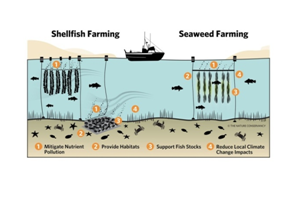
The Fishing industry can use the following measures to decrease the pollution caused by them in the marine ecosystem.
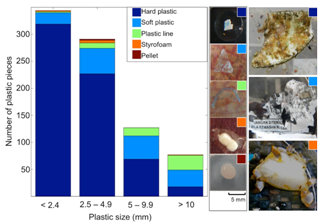
The above diagram represents the plastic pollutants spread by the industries in the ocean. These plastics cause water pollution and also result in the quality degradation in the seafood.
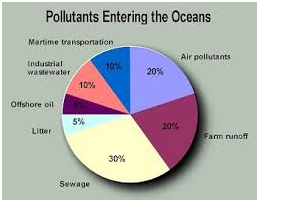
The graph shows other kinds of pollutants entering the oceans, thereby adding to the pollution and environment deterioration [8].
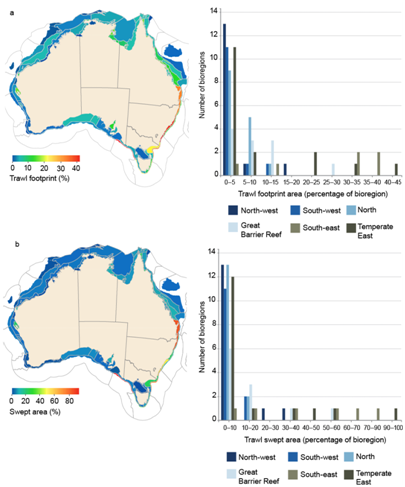
The diagram represents a reduction in the number of trawl footprints in Australia due to overfishing. Fish farming has considerably grown over the years as the consumption of the seafood has increased all over the world along with its population. The quantity and the quality of the fish are reducing due to over-farming of fishes and spread of pollution in the oceans.
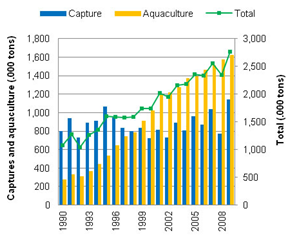
The above graph represents the growth in aquaculture over a period of years. The chart shows positive growth in aquaculture than natural fishing.
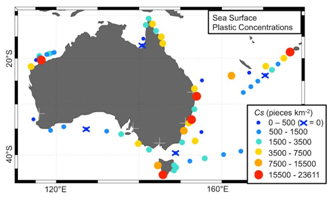
The map shows the concentration of plastic pollutants on the surface of the seawater in Australia. There has been a significant advancemet in the pollutants over the period of time [9].
Therefore, the reduction of the losses will begin with the decline of the risks associated with the field and ensuring proper conservation of the environment. Again, the involvement of the government in the decision-making processes of conserving the ecosystem is also crucial, as it will form part of the stakeholders in the risk management. The risk associated with the ecosystem also has impacts on other sectors such as social welfare, which calls for inclusive participation responsibility uptakes of the citizens to ensure — for example, empowering the society through education on some of the conservation measures. The risks associated with the hazards of the industrial pollutants is several, apart from polluting the oceans, it will also have a negative impact on the environment and people. The ecosystem is at a higher risk, and it will have a domino effect on all the ecosystems, eventually putting human life in dangers. The government must take necessary measures to allow sustainable farming on the one hand and conserve the environment on the other side. Edification of the people, producers, and consumers is essential, as only then they will completely comprehend the gravity of the situation [10].
Research Design and Methodology
This chapter highlights the methods, which the research has employed in the collection of data, and: target population, the validity of the instruments, sampling procedures, and data analysis. The research is imperative as it will provide a comprehensive understanding of the threat at hand and will help in determining appropriate remedial measures against the same. The researcher can use multiple research techniques at his disposal. The research can be conducted via either a secondary source or a primary source. The secondary source will involve the gathering of relevant literature data from published or unpublished yet relevant sources. The primary data source includes the first-hand collection of data from the source. Both methods have their own set of significance.
The methodology used for the purpose of this research will be both primary research and secondary research. The investigator will gather the data by him or her from the respected stakeholders associated with aquaculture farming. The researcher will also used relevant literature sources to support his findings based on the primary sources [11].
Research Design
The study employed an investigative approach to gain more data. Mugenda & Mugenda (1999), the design is a systematic inquiry to which the researcher used while in the field. The case study provided the researcher with full data on the critical factors contributed by pollution to the fish industry. The researcher performed the study in a natural setting, implying that the phenomena under study are investigated as they are.
The researcher therefore will require a lot of time and patience from the researcher to gain an unbiased perspective from the respondents. The researcher must undertake the research with utmost seriousness and dedication to arrive at accurate results. If not then the entire exercise will prove to be a futile attempt. A necessary research timeline is imperative for the research so that the research is complete within a proper timeframeThe researcher will implement qualitative data analysis and collection [12].
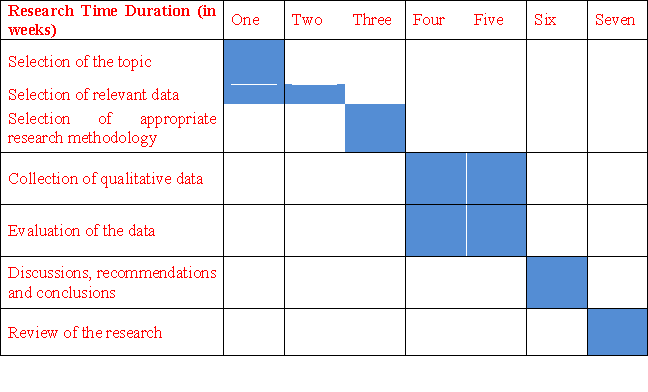
Study Area
The research was conducted at the Fish pond inan Australian firm.
Target Population
The study had a target of 60 respondents from a fishpond in Australia and aimed at the top management, both large and medium firms that run the activity commercially.
Sampling Techniques
The researcher’ consisted of 20 respondents and used 30% (Mugenda & Mugenda, 1999) to meet the target size.
|
Respondents |
Target population |
Sample size |
|
Large firms |
25 |
6 |
|
Middle firms |
25 |
10 |
|
Non-commercial |
10 |
2 |
|
Total |
60 |
18 |
Data Collection
The researcher performed a guided questionnaire and interview. According to Kothari (2008), surveys involve typed or printed questions. The researcher conducted this questionnaire to the large firms and aimed at addressing the objectives of how the ecosystem has been altered by pollution. There was subject to observation where the researcher obtained data from what is going on in the area. The place was able to deduce some impacts that have much affected the production and fish firm industry at all.The data will also be collected via the literature available in the form of books, journals and the other relevant published sources. The researcher may also use the unpublished yet viable literature sources to make the study comprehensive and complete.
Implementation and Results
This comprises of the analyzed data and results from the fish farms. The water pollution in the area has subjected most farmers back to losses. There is rapid destruction of fishponds due to the issue of pollution, which has killed much fish. The water pollution not only hurting the firms has also brought about a weak market in the sector. Through the collected data from filled questionnaires, it shows that most of the fishpond suffers a lot from the waste from the major industries in the area, and it is arising from failure of management to take in to control the disposal of treated waste.
The results show that water contributes to 80% of the main activities in the area and considering the misuse arising from the contamination. Through the subjection of interviews, responses from the large firm's holders showed that the impact of water pollution has made life harder and especially those who are narrowed to fish farming [4].
The outcome of the contamination has been a calamity in the area. To the farmers in the area, since there is less production of fish for sale, the market has been able to produce fewer fish. This has also contributed to a slow economy and leading government failure to consider firms during the budget. The fish production has been a challenge since the firms are in fear of getting all fish death.
There is a data presentation showing the projection of results gained:
|
|
frequency |
percent |
Cumulative |
|
Large firms |
12 |
23.6 |
23.6 |
|
Middle-firms |
30 |
34.7 |
100 |
|
Non-commercial |
24 |
41.7 |
|
|
Total |
|
100 |
|
The most affected parts in the area show that 41.7% of the firms are non-commercial investors in fish firms. The display that they lack most improvised means to avoid the mass effect of pollution to the fish reared hence not able to meet the target production
The environmental probability of affecting fish firms
|
|
Frequency |
percent |
Cumulative frequency |
|
NO |
23 |
35.6 |
35.6 |
|
YES |
12 |
64.4 |
100 |
|
Total |
35 |
100 |
|
64.4% of the residents agreed that there is a contrary impulse impact on the production of fish arising from the pollution of water. There is 35.6% disagreeing, and this was from the residents not versed with farming.
Discussion
The fish industry started just from small farmers contributing capital to rear fish [2]. The entry was performed for commercial purposes, and it showed a positive adaptive nature.
The stakeholders designed a way to invest in massive production, and the impact of pollution came in when the emerged diverse production and many farmers considering ready markets decided to venture into significant production. There is a high risk that the area is prone to diseases and another environmental hazard, such as infertility of lands.
The fishing industry has multiple issues; it not only leads to water pollution but also affects the population of the fish and degradation of the marine habitat. More and more land is being used for aquaculture farming, which causes the area to become infertile in the long haul. The size of the fishing industry has to be brought down, looking at the recent surge in the fishing industry. The trawling is affecting the ocean floors by moving the sediments and destroying the coral reefs in the process. Coral reefs are essential to maintain the aquatic ecosystem. The water pollution, on the other hand, must also be curbed. One of the significant impacts of aquaculture is the translocation of the fishes [13].
The natural catchment areas of the fishes are devoid of it. Besides this, there has also been an epidemic of diseases and pests in the fishes. In some instances, it has led to the abandoning of the large aquaculture farms in Australia, as they were not in usable condition. It, however, has brought about no changes in the intensity of fish farming. The diseased fishes, when exported or consumed in the local markets, bring a plethora of health hazards to human beings [14].
Risk Reduction Strategies
The risk mitigation strategies to be used for fish farming includes adopting an ecosystem approach towards the aquaculture as it is growing intensively. The government, NGO's and the producers can work in unison to prevent environmental deterioration and progress towards sustainable occupation and safe environment. Appropriate legal frameworks must be determined like code of conduct, codes of practice, and self-regulatory laws must be effectively enforced. The government must ensure that the organisations are using practical tools and mechanisms to curb pollution and protect aquatic life.
Work Limitations
The major hindrance on the path of the project was the time dedication. As the research consisted both of primary and secondary research, a lot of time had to be invested in conducting the research. Data collection and segregation were other issues. There was a lot of opposing data that stated opposite views; the researcher had to perform an in-depth study to reach a feasible solution. Most of the secondary data was outdated and old. The interviews and questionnaire consumed a lot of time and energy. The participants were not available on allotted timings, and the research had to shift according to their availability.
Ethical Consideration
While conducting research ethics play a significant role, the researcher must follow ethics to fulfil the requisites of the research. All the moral codes and ethical standards must be complied with compulsorily. The participants of the investigation will have to be informed in advance, and their consent must be taken before the initiation of the research. Every information provided to them must be accurate and not misleading. The researcher must not show any bias, and the study must not include provocative and offensive information. The researcher must maintain the dignity of the participants, and if they wish to remain anonymous, it must be allowed. The researcher must not use false information in the name of the participants and give them due to recognition for the efforts [16].
Conclusion and Future Works
Water pollution has an impact on fishpond firms. Many losses have been observed in the firms hence reduction in production. The effect has not also affected the firm but also made life hard and subjected humans to diseases.
The fact of pollution has damaged and discourages the excellent use of water. The fact that most of the chemicals drawn into the water by big industries have killed the main economic activity in the area leading to job opportunity loss.
The authority concern plans in the future to ensure strategies in place to gap the pollution of water and ensure strict rules to the industries and persons involved.
References
[1] Anh, P. T., Kroeze, C., Bush, S. R., & Mol, A. P. (2010). Water pollution by intensive brackish shrimp farming in south-east Vietnam: Causes and options for control. Agricultural Water Management, 97(6), 872-882.
[2] Britton, J. R., Gozlan, R. E., &Copp, G. H. (2011). Managing non native fish in the environment. Fish and fisheries, 12(3), 256-274.
[3] Brouwer, R., Akter, S., Brander, L., & Haque, E. (2007). Socioeconomic vulnerability and adaptation to environmental risk: a case study of climate change and flooding in Bangladesh. Risk Analysis: An International Journal, 27(2), 313-326.
[4] Costa-Pierce, B. A. (2010). Sustainable ecological aquaculture systems: the need for a new social contract for aquaculture development. Marine Technology Society Journal, 44(3), 88-112.
[5] Curran-Cournane, F., Cain, T., Greenhalgh, S., &Samarsinghe, O. (2016). Attitudes of a farming community towards urban growth and rural fragmentation—An Auckland case study. Land Use Policy, 58, 241-250.
[6] Hamilton-Webb, A., Manning, L., Naylor, R., & Conway, J. (2017). The relationship between risk experience and risk response: a study of farmers and climate change. Journal of Risk Research, 20(11), 1379-1393.
[7] Holsman, K., Samhouri, J., Cook, G., Hazen, E., Olsen, E., Dillard, M., ... & Andrews, K. (2017). An ecosystem based approach to marine risk assessment. Ecosystem Health and Sustainability, 3(1), e01256.
[8] Löhr, A., Savelli, H., Beunen, R., Kalz, M., Ragas, A., & Van Belleghem, F. (2017). Solutions for global marine litter pollution. Current opinion in environmental sustainability, 28, 90-99.
[9] Monaghan, R. M., De Klein, C. A., &Muirhead, R. W. (2008). Prioritisation of farm scale remediation efforts for reducing losses of nutrients and faecal indicator organisms to waterways: A case study of New Zealand dairy farming. Journal of environmental management, 87(4), 609-622.
[10] Naylor, R. L., Goldburg, R. J., Primavera, J. H., Kautsky, N., Beveridge, M. C., Clay, J., ... &Troell, M. (2000). Effect of aquaculture on world fish supplies. Nature, 405(6790), 1017.
[11] Ridoutt, B. G., Hadjikakou, M., Nolan, M., & Bryan, B. A. (2018). From water-use to water-scarcity footprinting in environmentally extended input-output analysis. Environmental science & technology, 52(12), 6761-6770.
[12] Avio, C.G., Gorbi, S., Milan, M., Benedetti, M., Fattorini, D., d'Errico, G., Pauletto, M., Bargelloni, L. and Regoli, F., 2015. Pollutants bioavailability and toxicological risk from microplastics to marine mussels. Environmental Pollution, 198, pp.211-222.
[13] Prüss-Üstün, A., Wolf, J., Corvalán, C., Bos, R. and Neira, M., 2016. Preventing disease through healthy environments: a global assessment of the burden of disease from environmental risks. World Health Organization.
[14] Phillips, B.F. and Pérez-Ramírez, M. eds., 2017. Climate Change Impacts on Fisheries and Aquaculture: A Global Analysis (Vol. 1). John Wiley & Sons.
[15] Hook, S.E., Doan, H., Gonzago, D., Musson, D., Du, J., Kookana, R., Sellars, M.J. and Kumar, A., 2018. The impacts of modern-use pesticides on shrimp aquaculture: An assessment for north eastern Australia. Ecotoxicology and environmental safety, 148, pp.770-780.
[16] Lauer, P., López, L., Sloan, E., Sloan, S. and Doroudi, M., 2015. Learning from the systematic approach to aquaculture zoning in South Australia: A case study of aquaculture (Zones–Lower Eyre Peninsula) Policy 2013. Marine Policy, 59, pp.77-84.












